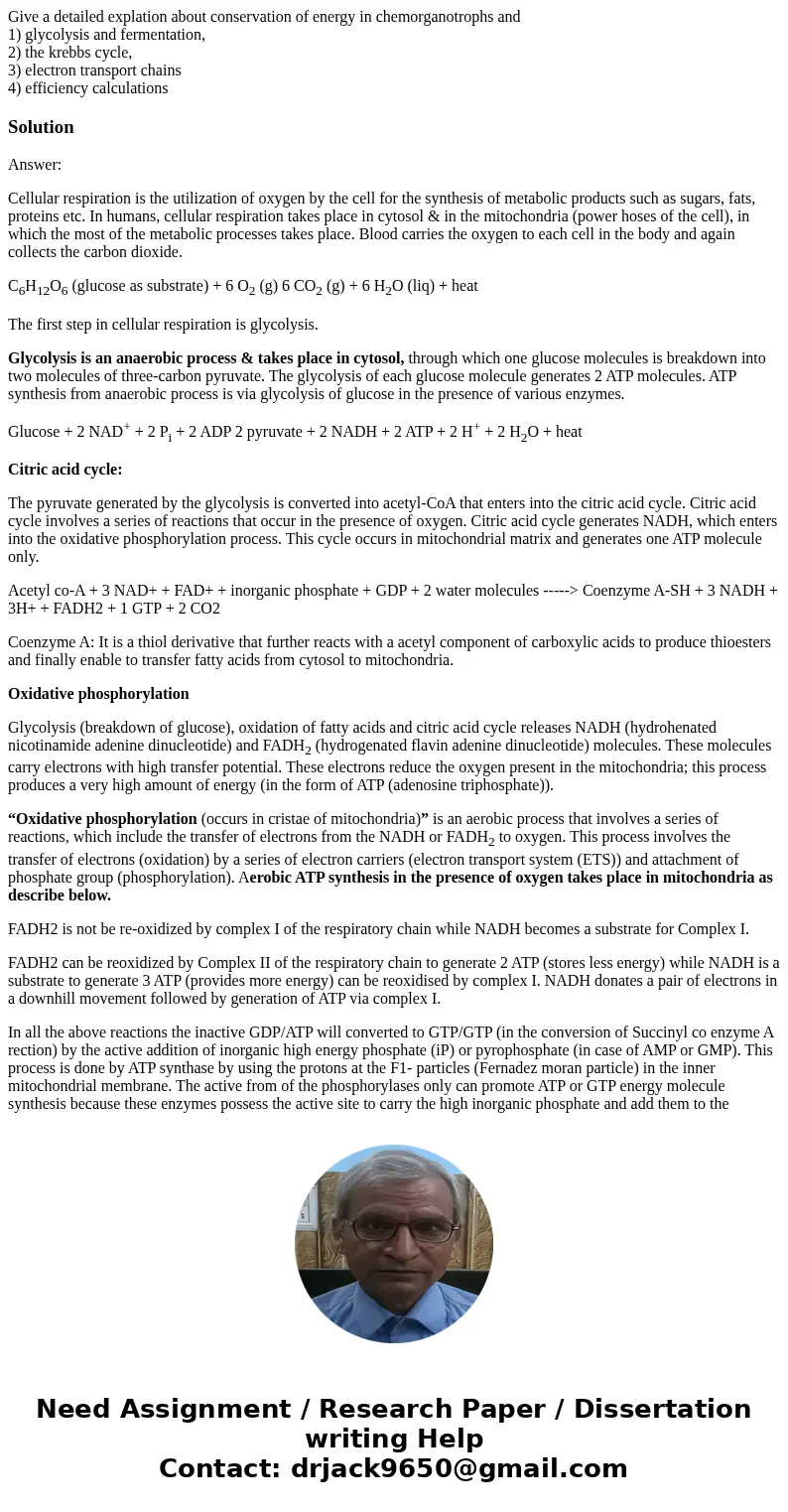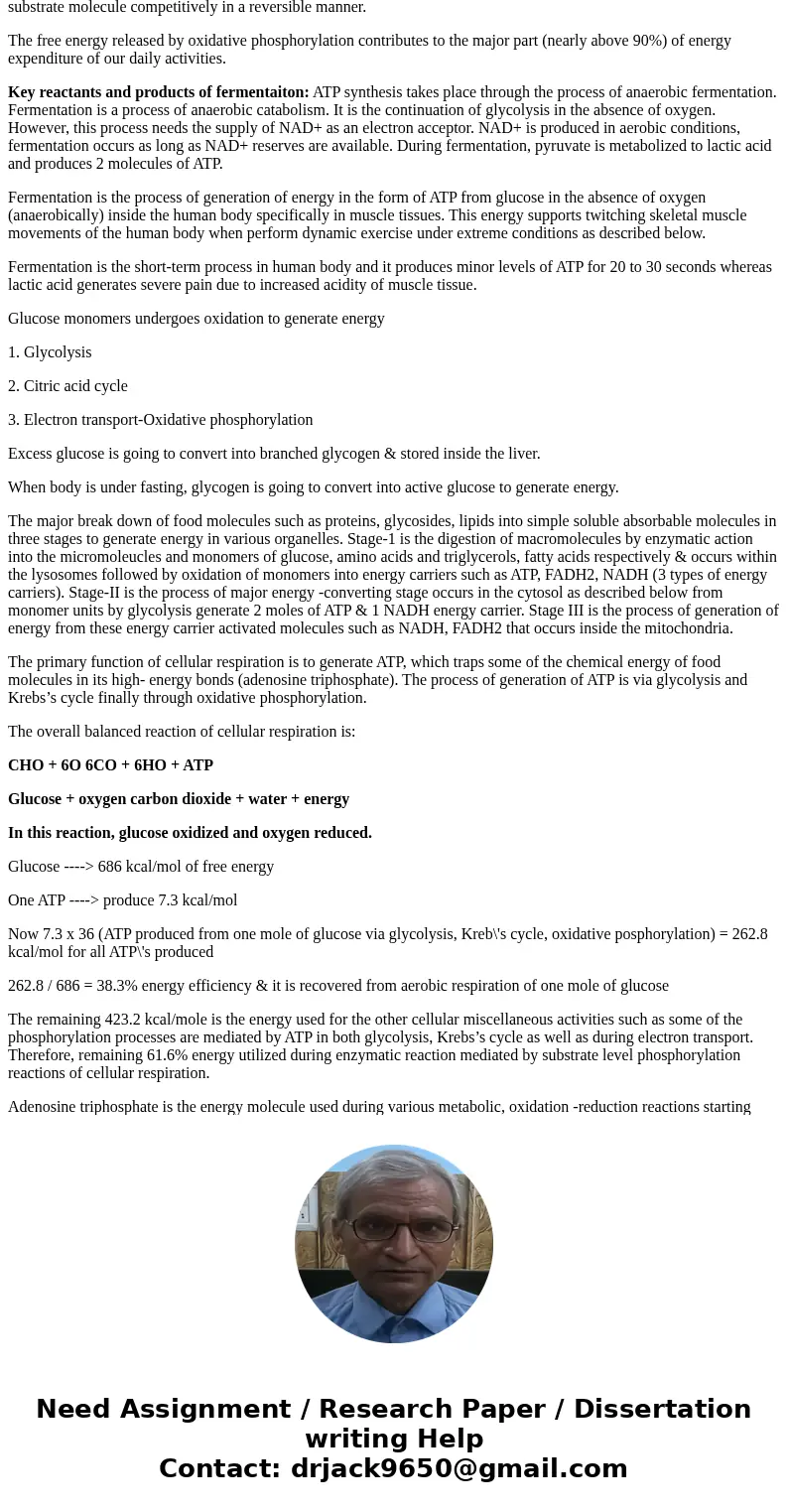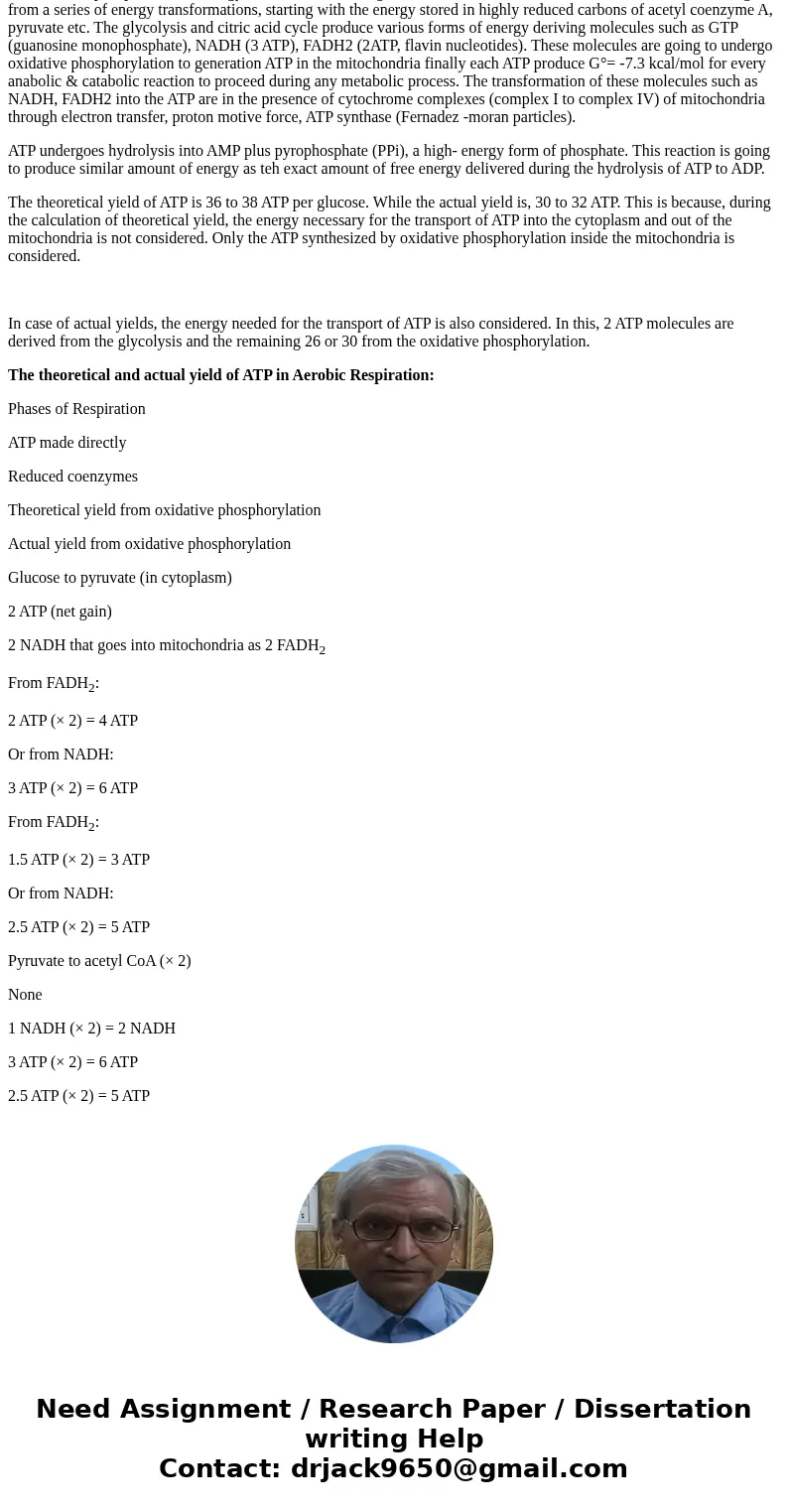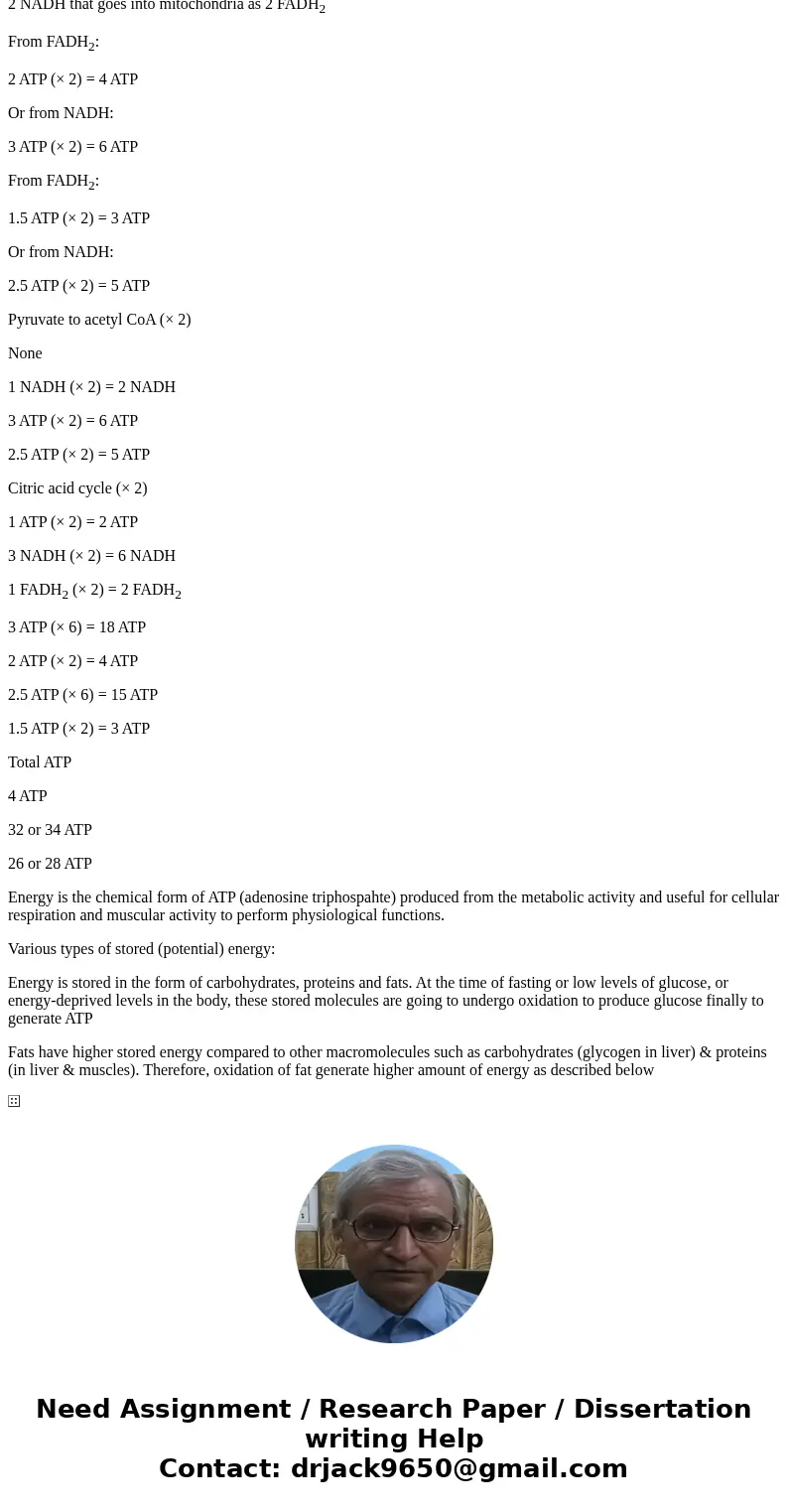Give a detailed explation about conservation of energy in ch
Give a detailed explation about conservation of energy in chemorganotrophs and
1) glycolysis and fermentation,
2) the krebbs cycle,
3) electron transport chains
4) efficiency calculations
Solution
Answer:
Cellular respiration is the utilization of oxygen by the cell for the synthesis of metabolic products such as sugars, fats, proteins etc. In humans, cellular respiration takes place in cytosol & in the mitochondria (power hoses of the cell), in which the most of the metabolic processes takes place. Blood carries the oxygen to each cell in the body and again collects the carbon dioxide.
C6H12O6 (glucose as substrate) + 6 O2 (g) 6 CO2 (g) + 6 H2O (liq) + heat
The first step in cellular respiration is glycolysis.
Glycolysis is an anaerobic process & takes place in cytosol, through which one glucose molecules is breakdown into two molecules of three-carbon pyruvate. The glycolysis of each glucose molecule generates 2 ATP molecules. ATP synthesis from anaerobic process is via glycolysis of glucose in the presence of various enzymes.
Glucose + 2 NAD+ + 2 Pi + 2 ADP 2 pyruvate + 2 NADH + 2 ATP + 2 H+ + 2 H2O + heat
Citric acid cycle:
The pyruvate generated by the glycolysis is converted into acetyl-CoA that enters into the citric acid cycle. Citric acid cycle involves a series of reactions that occur in the presence of oxygen. Citric acid cycle generates NADH, which enters into the oxidative phosphorylation process. This cycle occurs in mitochondrial matrix and generates one ATP molecule only.
Acetyl co-A + 3 NAD+ + FAD+ + inorganic phosphate + GDP + 2 water molecules -----> Coenzyme A-SH + 3 NADH + 3H+ + FADH2 + 1 GTP + 2 CO2
Coenzyme A: It is a thiol derivative that further reacts with a acetyl component of carboxylic acids to produce thioesters and finally enable to transfer fatty acids from cytosol to mitochondria.
Oxidative phosphorylation
Glycolysis (breakdown of glucose), oxidation of fatty acids and citric acid cycle releases NADH (hydrohenated nicotinamide adenine dinucleotide) and FADH2 (hydrogenated flavin adenine dinucleotide) molecules. These molecules carry electrons with high transfer potential. These electrons reduce the oxygen present in the mitochondria; this process produces a very high amount of energy (in the form of ATP (adenosine triphosphate)).
“Oxidative phosphorylation (occurs in cristae of mitochondria)” is an aerobic process that involves a series of reactions, which include the transfer of electrons from the NADH or FADH2 to oxygen. This process involves the transfer of electrons (oxidation) by a series of electron carriers (electron transport system (ETS)) and attachment of phosphate group (phosphorylation). Aerobic ATP synthesis in the presence of oxygen takes place in mitochondria as describe below.
FADH2 is not be re-oxidized by complex I of the respiratory chain while NADH becomes a substrate for Complex I.
FADH2 can be reoxidized by Complex II of the respiratory chain to generate 2 ATP (stores less energy) while NADH is a substrate to generate 3 ATP (provides more energy) can be reoxidised by complex I. NADH donates a pair of electrons in a downhill movement followed by generation of ATP via complex I.
In all the above reactions the inactive GDP/ATP will converted to GTP/GTP (in the conversion of Succinyl co enzyme A rection) by the active addition of inorganic high energy phosphate (iP) or pyrophosphate (in case of AMP or GMP). This process is done by ATP synthase by using the protons at the F1- particles (Fernadez moran particle) in the inner mitochondrial membrane. The active from of the phosphorylases only can promote ATP or GTP energy molecule synthesis because these enzymes possess the active site to carry the high inorganic phosphate and add them to the substrate molecule competitively in a reversible manner.
The free energy released by oxidative phosphorylation contributes to the major part (nearly above 90%) of energy expenditure of our daily activities.
Key reactants and products of fermentaiton: ATP synthesis takes place through the process of anaerobic fermentation. Fermentation is a process of anaerobic catabolism. It is the continuation of glycolysis in the absence of oxygen. However, this process needs the supply of NAD+ as an electron acceptor. NAD+ is produced in aerobic conditions, fermentation occurs as long as NAD+ reserves are available. During fermentation, pyruvate is metabolized to lactic acid and produces 2 molecules of ATP.
Fermentation is the process of generation of energy in the form of ATP from glucose in the absence of oxygen (anaerobically) inside the human body specifically in muscle tissues. This energy supports twitching skeletal muscle movements of the human body when perform dynamic exercise under extreme conditions as described below.
Fermentation is the short-term process in human body and it produces minor levels of ATP for 20 to 30 seconds whereas lactic acid generates severe pain due to increased acidity of muscle tissue.
Glucose monomers undergoes oxidation to generate energy
1. Glycolysis
2. Citric acid cycle
3. Electron transport-Oxidative phosphorylation
Excess glucose is going to convert into branched glycogen & stored inside the liver.
When body is under fasting, glycogen is going to convert into active glucose to generate energy.
The major break down of food molecules such as proteins, glycosides, lipids into simple soluble absorbable molecules in three stages to generate energy in various organelles. Stage-1 is the digestion of macromolecules by enzymatic action into the micromoleucles and monomers of glucose, amino acids and triglycerols, fatty acids respectively & occurs within the lysosomes followed by oxidation of monomers into energy carriers such as ATP, FADH2, NADH (3 types of energy carriers). Stage-II is the process of major energy -converting stage occurs in the cytosol as described below from monomer units by glycolysis generate 2 moles of ATP & 1 NADH energy carrier. Stage III is the process of generation of energy from these energy carrier activated molecules such as NADH, FADH2 that occurs inside the mitochondria.
The primary function of cellular respiration is to generate ATP, which traps some of the chemical energy of food molecules in its high- energy bonds (adenosine triphosphate). The process of generation of ATP is via glycolysis and Krebs’s cycle finally through oxidative phosphorylation.
The overall balanced reaction of cellular respiration is:
CHO + 6O 6CO + 6HO + ATP
Glucose + oxygen carbon dioxide + water + energy
In this reaction, glucose oxidized and oxygen reduced.
Glucose ----> 686 kcal/mol of free energy
One ATP ----> produce 7.3 kcal/mol
Now 7.3 x 36 (ATP produced from one mole of glucose via glycolysis, Kreb\'s cycle, oxidative posphorylation) = 262.8 kcal/mol for all ATP\'s produced
262.8 / 686 = 38.3% energy efficiency & it is recovered from aerobic respiration of one mole of glucose
The remaining 423.2 kcal/mole is the energy used for the other cellular miscellaneous activities such as some of the phosphorylation processes are mediated by ATP in both glycolysis, Krebs’s cycle as well as during electron transport. Therefore, remaining 61.6% energy utilized during enzymatic reaction mediated by substrate level phosphorylation reactions of cellular respiration.
Adenosine triphosphate is the energy molecule used during various metabolic, oxidation -reduction reactions starting from a series of energy transformations, starting with the energy stored in highly reduced carbons of acetyl coenzyme A, pyruvate etc. The glycolysis and citric acid cycle produce various forms of energy deriving molecules such as GTP (guanosine monophosphate), NADH (3 ATP), FADH2 (2ATP, flavin nucleotides). These molecules are going to undergo oxidative phosphorylation to generation ATP in the mitochondria finally each ATP produce G°= -7.3 kcal/mol for every anabolic & catabolic reaction to proceed during any metabolic process. The transformation of these molecules such as NADH, FADH2 into the ATP are in the presence of cytochrome complexes (complex I to complex IV) of mitochondria through electron transfer, proton motive force, ATP synthase (Fernadez -moran particles).
ATP undergoes hydrolysis into AMP plus pyrophosphate (PPi), a high- energy form of phosphate. This reaction is going to produce similar amount of energy as teh exact amount of free energy delivered during the hydrolysis of ATP to ADP.
The theoretical yield of ATP is 36 to 38 ATP per glucose. While the actual yield is, 30 to 32 ATP. This is because, during the calculation of theoretical yield, the energy necessary for the transport of ATP into the cytoplasm and out of the mitochondria is not considered. Only the ATP synthesized by oxidative phosphorylation inside the mitochondria is considered.
In case of actual yields, the energy needed for the transport of ATP is also considered. In this, 2 ATP molecules are derived from the glycolysis and the remaining 26 or 30 from the oxidative phosphorylation.
The theoretical and actual yield of ATP in Aerobic Respiration:
Phases of Respiration
ATP made directly
Reduced coenzymes
Theoretical yield from oxidative phosphorylation
Actual yield from oxidative phosphorylation
Glucose to pyruvate (in cytoplasm)
2 ATP (net gain)
2 NADH that goes into mitochondria as 2 FADH2
From FADH2:
2 ATP (× 2) = 4 ATP
Or from NADH:
3 ATP (× 2) = 6 ATP
From FADH2:
1.5 ATP (× 2) = 3 ATP
Or from NADH:
2.5 ATP (× 2) = 5 ATP
Pyruvate to acetyl CoA (× 2)
None
1 NADH (× 2) = 2 NADH
3 ATP (× 2) = 6 ATP
2.5 ATP (× 2) = 5 ATP
Citric acid cycle (× 2)
1 ATP (× 2) = 2 ATP
3 NADH (× 2) = 6 NADH
1 FADH2 (× 2) = 2 FADH2
3 ATP (× 6) = 18 ATP
2 ATP (× 2) = 4 ATP
2.5 ATP (× 6) = 15 ATP
1.5 ATP (× 2) = 3 ATP
Total ATP
4 ATP
32 or 34 ATP
26 or 28 ATP
Energy is the chemical form of ATP (adenosine triphospahte) produced from the metabolic activity and useful for cellular respiration and muscular activity to perform physiological functions.
Various types of stored (potential) energy:
Energy is stored in the form of carbohydrates, proteins and fats. At the time of fasting or low levels of glucose, or energy-deprived levels in the body, these stored molecules are going to undergo oxidation to produce glucose finally to generate ATP
Fats have higher stored energy compared to other macromolecules such as carbohydrates (glycogen in liver) & proteins (in liver & muscles). Therefore, oxidation of fat generate higher amount of energy as described below




 Homework Sourse
Homework Sourse